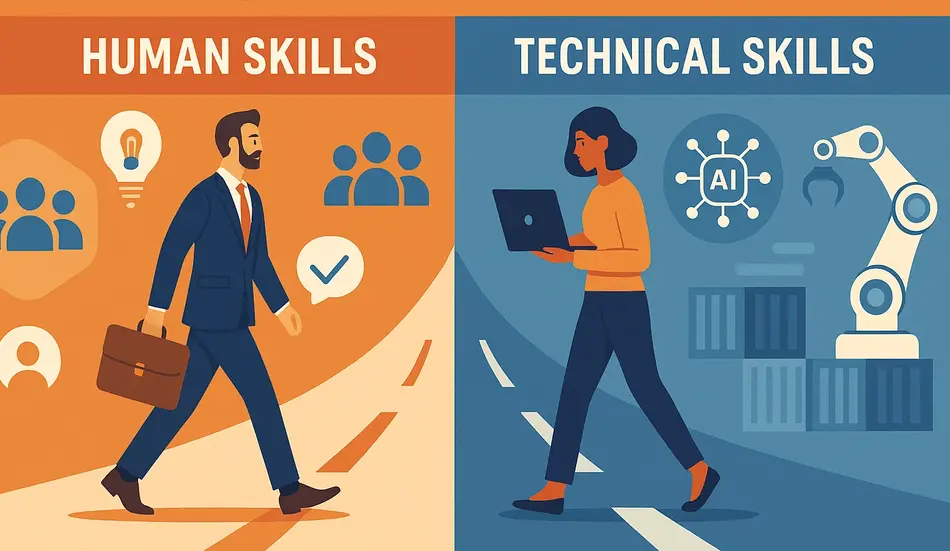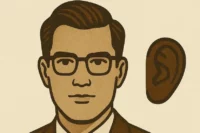Understanding the Shifting Landscape: How AI is Reshaping Employment
In today’s rapidly evolving job market, artificial intelligence and automation are fundamentally transforming how we work. The question “How safe is your job in a world reshaped by AI?” has become increasingly urgent for professionals across industries. According to recent projections from the World Economic Forum, we’re witnessing a dramatic shift in employment patterns—while 92 million jobs may be displaced by 2030, approximately 170 million new positions will emerge, particularly in technology, healthcare, and sustainable energy sectors.
This transformation represents both a challenge and an opportunity. Understanding the two-track career development approach—simultaneously building technical literacy while enhancing uniquely human skills—has become essential for navigating this new landscape successfully. This comprehensive guide explores the major trends reshaping work, identifies which careers are declining versus ascending, and provides actionable strategies to future-proof your professional journey.
Five Major Trends Reshaping the Global Workforce
Technological Acceleration
The most significant driver of workplace transformation is undoubtedly technological advancement. AI, robotics, and digital tools are creating entirely new job categories while fundamentally changing how businesses operate. This technological revolution brings both opportunities and challenges—eliminating routine positions while creating demand for specialized technical expertise.
The two-track career development model becomes particularly relevant here, as professionals must balance technical adaptation with cultivating distinctly human capabilities that machines cannot easily replicate. This dual approach ensures resilience in a rapidly changing job market.
Geopolitical Realignment
Tensions between major powers, particularly the United States and China, are disrupting traditional global trade patterns and economic partnerships. These shifts are forcing businesses to reconsider established models and navigate new challenges in international markets.
Professionals with cross-cultural competence, geopolitical awareness, and adaptability will find themselves better positioned to thrive amid these changes. The two-track career development strategy emphasizes the importance of understanding these global dynamics alongside technical skill development.
Demographic Transformation
Aging populations in developed nations are driving increased demand for healthcare services, while younger, expanding workforces in lower-income regions create greater needs for education and training. South Korea exemplifies this trend, with its rapidly aging population expected to outnumber working-age citizens in the coming decades.
This demographic shift creates opportunities for those in healthcare, education, and related fields who can adapt their skills to serve changing population needs. The two-track career development approach encourages professionals to consider these demographic trends when planning their career trajectories.
Economic Challenges
Rising living costs and slower economic growth are compelling workers to focus more intensively on upskilling and finding creative ways to remain competitive. The traditional model of linear career progression is giving way to more flexible, adaptable approaches to professional development.
The two-track career development framework addresses this reality by emphasizing continuous learning and skill diversification as essential components of career resilience in uncertain economic times.
Green Transition
Climate change initiatives are driving demand for new roles in renewable energy, environmental engineering, and sustainability. This transition represents one of the most significant employment opportunities of the coming decade.
Professionals who can integrate environmental expertise with technical skills will find themselves particularly well-positioned in this evolving landscape. The two-track career development strategy recognizes sustainability as a critical component of future career planning.
Jobs in Decline: Understanding the Impact of Automation
Several traditional career paths are facing significant disruption due to technological advancement:
Administrative and Clerical Roles
- Postal Service Clerks: Automated sorting systems are replacing human workers who previously organized mail for delivery
- Data Entry Clerks: AI tools and data analytics platforms are streamlining the process of collecting, entering, and analyzing information
- Administrative Assistants: AI-powered scheduling and productivity apps like Calendly are handling tasks that once required human intervention
Customer Service and Financial Positions
- Bank Tellers: Online banking and mobile applications now enable customers to complete transactions without visiting physical branches
- Cashiers and Ticket Clerks: Self-checkout systems and automated ticket counters are becoming the norm across retail and entertainment venues
What’s particularly notable about these declining roles is their connection to emerging opportunities. The two-track career development approach recognizes that understanding these connections is crucial for effective career transitions.
Growth Sectors: Where New Opportunities Are Emerging
As traditional roles decline, exciting new career paths are opening up across multiple sectors:
Technology Leadership
- Big Data Specialists: These professionals analyze massive datasets to extract insights that drive business decisions
- Fintech Engineers: Developers creating next-generation payment systems and digital banking platforms
- AI and Machine Learning Specialists: Experts designing algorithms that power everything from chatbots to autonomous vehicles
- Software and Applications Developers: Builders of the digital tools we use daily across mobile and web platforms
- Security Management Specialists: Professionals ensuring systems, networks, and data remain protected from cyber threats
Sustainable Development
While not in the top five fastest-growing roles, sustainability positions continue to see strong demand:
- Renewable Energy Engineers: Specialists designing and implementing clean energy solutions
- Autonomous Vehicle Specialists: Experts developing self-driving technologies that promise to revolutionize transportation
- Environmental Engineers: Professionals creating solutions to address climate challenges
Healthcare and Education
These sectors continue to experience significant growth driven by demographic shifts:
- Nursing Professionals: Caregivers supporting aging populations across developed nations
- Higher Education Teachers: Educators preparing the next generation for an evolving job market
The Two-Track Career Development Strategy: Technical + Human Skills
To remain competitive in this transforming landscape, professionals must adopt a two-track career development approach that balances technical and human capabilities:
Track One: Technical Literacy and Specialization
The fastest-growing skills in high demand center around technology:
- AI and Machine Learning: Understanding how to work with and leverage artificial intelligence systems
- Big Data Analytics: Ability to extract meaningful insights from large datasets
- Cybersecurity: Knowledge of how to protect digital assets and information
- General Tech Literacy: Basic understanding of digital tools and platforms
Contrary to popular belief, coding remains a foundational skill worth developing. Much like mathematics has become a universal requirement regardless of profession, basic coding knowledge is becoming essential across industries. The two-track career development model recognizes that even non-technical roles increasingly require some level of technical understanding.
Track Two: Human-Centered Capabilities
While technical skills are crucial, uniquely human capabilities are equally important:
- Creative Thinking: The ability to generate novel ideas and innovative solutions
- Leadership: Inspiring and guiding teams through complex challenges
- Emotional Intelligence: Understanding and navigating human emotions and relationships
- Adaptability: Quickly adjusting to changing circumstances and requirements
- Cross-Cultural Competence: Working effectively across diverse cultural contexts
The two-track career development approach emphasizes that these human skills become even more valuable as routine tasks become automated. The most successful professionals will combine technical knowledge with these distinctly human capabilities.
Need Career Advice?
Are you wondering how to implement a two-track career development strategy in your professional journey? WhatJobs Career Advice offers personalized guidance to help you navigate the changing job market. Our expert advisors can help you identify which technical skills to develop alongside your human capabilities, creating a balanced approach that ensures long-term career resilience.
Explore Career Resources at WhatJobs →Practical Steps for Future-Proofing Your Career
1. Embrace Continuous Learning
The World Economic Forum report indicates that by 2030, 59% of workers will need significant retraining. The two-track career development approach recognizes this reality and emphasizes lifelong learning as essential:
- Dedicate regular time to skill development
- Pursue both formal education and self-directed learning
- Stay informed about emerging trends in your industry
- Develop learning networks with peers and mentors
2. Identify Transferable Skills
Understanding the correlation between declining and emerging roles is crucial:
- Analyze how your current skills might apply to growth sectors
- Identify the core competencies that transfer across industries
- Focus on developing versatile capabilities that remain valuable as specific roles evolve
The two-track career development strategy emphasizes recognizing these connections to facilitate smoother career transitions.
3. Combine Technical and Domain Expertise
Some of the most valuable professionals will be those who can bridge technical knowledge with expertise in specific domains:
- Healthcare professionals with data analysis skills
- Environmental specialists with AI knowledge
- Financial experts with cybersecurity understanding
This hybrid approach exemplifies the two-track career development philosophy by integrating technical literacy with specialized domain knowledge.
4. Develop a Personal Brand Around Adaptability
Position yourself as someone who embraces change rather than resists it:
- Document your learning journey publicly
- Share insights about emerging trends in your field
- Demonstrate how you’ve successfully navigated previous transitions
The two-track career development framework values this adaptability as a core professional attribute.
5. Build a Diverse Professional Network
Connections across different industries and specialties provide valuable perspective:
- Engage with professionals outside your immediate field
- Participate in cross-disciplinary projects and initiatives
- Seek mentors with diverse backgrounds and experiences
This network diversity supports the two-track career development approach by exposing you to varied perspectives and opportunities.
Hiring? Post Jobs for Free with WhatJobs
Are you an employer seeking talent with a two-track career development mindset? WhatJobs connects forward-thinking companies with candidates who understand the importance of balancing technical literacy with human-centered skills. Our platform helps you find professionals prepared to thrive in today’s rapidly evolving workplace.
Post Jobs Free on WhatJobs →FAQ: Two-Track Career Development in the AI Era
What exactly is the two-track career development approach?
The two-track career development strategy involves simultaneously developing technical literacy (like understanding AI, data analytics, and digital tools) alongside distinctly human capabilities (such as creative thinking, leadership, and emotional intelligence). This balanced approach ensures professional resilience as automation transforms the workplace. While machines increasingly handle routine tasks, humans who can combine technical understanding with uniquely human skills will remain valuable and adaptable in an evolving job market.
How can I determine which technical skills are worth investing in for my specific career path?
To identify the most valuable technical skills for your two-track career development journey, start by researching technology trends specific to your industry. Look at job postings for roles you aspire to and note recurring technical requirements. Connect with professionals in your field who have successfully integrated technical skills into their work. Focus on foundational skills with broad applicability (like data analysis or basic coding) before specializing. Remember that the goal isn’t necessarily to become a technical expert but to develop sufficient literacy to collaborate effectively with specialists and leverage technology in your work.
Is it too late to pivot my career if I’m currently in a field threatened by automation?
It’s never too late to adapt your career path using the two-track career development approach. Many professionals successfully transition from declining fields to growth sectors by identifying transferable skills and strategically adding new capabilities. Start by analyzing how your existing expertise might apply to emerging roles—for example, a bank teller might leverage customer service experience and financial knowledge to move into fintech customer success. Invest in targeted upskilling through courses, certifications, or projects that demonstrate your capabilities. Focus on building bridges between your current expertise and future opportunities rather than starting entirely from scratch.
How can organizations support employees in developing both technical and human-centered skills?
Forward-thinking organizations can foster two-track career development by creating learning cultures that value both technical and human capabilities. Practical approaches include implementing rotation programs that expose employees to different functions, providing learning stipends for skill development, creating cross-functional project teams, and recognizing and rewarding continuous learning. Organizations should also consider partnering with educational institutions to develop customized training programs that address specific skill gaps. By investing in employee development across both technical and human dimensions, companies build more adaptable workforces while increasing employee engagement and retention.






